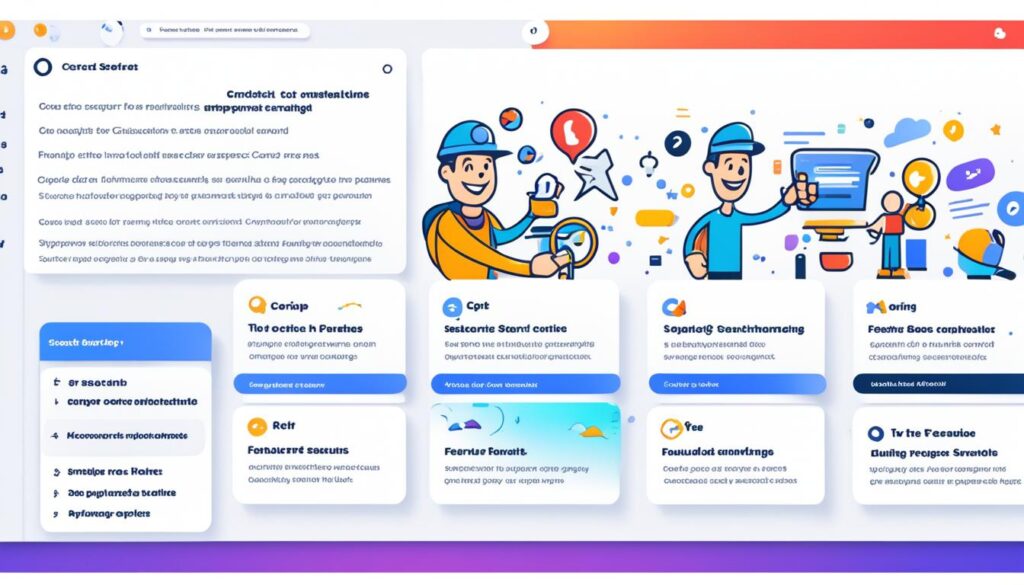Did you know that 95% of search engine users never click beyond the first page of search results? That’s a staggering statistic that illustrates the importance of optimizing your website to appear at the top of search engine rankings. While basic SEO practices can improve your visibility, incorporating advanced SEO techniques can give you a significant edge in driving more organic traffic to your site. In this article, we will explore 13 effective advanced SEO techniques that can help you boost your site traffic and improve your search engine rankings.
Key Takeaways:
- Advanced SEO techniques go beyond the basics and require a deep understanding of search engine algorithms and user behavior.
- Improving your content’s time to value can reduce bounce rates and increase dwell time and session duration.
- Topic clusters and strategic internal linking can improve your website’s topical authority and enhance search engine understanding.
- Maximizing SERP real estate through structured data, multimedia content, and Google Business Profile can increase visibility.
- Utilizing paid search ads for backlinks and optimizing for featured snippets can drive more organic traffic to your site.
Improve Your Content’s Time to Value
One of the key factors in SEO is the time it takes for users to derive value from your content. Maximizing the time to value not only improves the user experience but also positively impacts important website metrics like bounce rate, dwell time, and average session duration. When visitors quickly find the information they are looking for, they are more likely to stay on your site for longer periods, leading to increased engagement and better search rankings.
To improve your content’s time to value, it is crucial to prioritize the most important information and create a concise and engaging introduction. By presenting the most relevant and valuable content at the top of your page, you capture the attention of your audience and fulfill their immediate informational needs. This strategic placement can effectively reduce bounce rate, increase dwell time, and prolong the overall session duration.
Think of your introduction as a snapshot that encapsulates the essence of your content, enticing readers to explore further. Craft it with clarity, brevity, and strong emphasis on the value proposition you offer. By delivering immediate value to users, you not only optimize their engagement but also encourage them to delve deeper into your site, exploring more of your content and increasing the likelihood of conversion.
Keep in mind that the optimization of time to value is an ongoing process that requires continuous monitoring, analysis, and refinement. Continually reassess your content’s performance, identify areas for improvement, and tailor your approach to align with user expectations and search engine requirements.
Implementing these strategies and maximizing your content’s time to value can significantly impact your website’s success by enhancing user experience, reducing bounce rates, increasing dwell time, and ultimately improving search rankings. By prioritizing the delivery of immediate value to your audience, you will establish a strong foundation for engaging and retaining your site visitors.
Build Out Topic Clusters

In our quest to achieve topical authority and improve our website’s search engine rankings, we must embrace an advanced SEO technique known as topic clusters. Topic clusters involve creating a collection of articles or content pieces centered around a central topic.
By developing topic clusters, we provide comprehensive coverage on specific subjects, making it easier for users to find the information they need on our site. This not only enhances their browsing experience but also demonstrates our expertise and authority in the eyes of search engines.
To build topic clusters effectively, internal linking plays a crucial role. By strategically linking our cluster content to a pillar page, we reinforce the topical relevance and authority of our website. This internal linking architecture allows search engines to understand the relationships between our content pieces and further strengthens our SEO efforts.
Why Topic Clusters Are Important
Topic clusters are a powerful way to organize and present information on our site. They enable us to:
- Cover a range of related subtopics within a broader topic, allowing us to provide comprehensive resources for users.
- Establish our website as an authoritative source of information in a particular niche, showcasing our expertise to both users and search engines.
- Improve user engagement and dwell time by offering a cohesive and interconnected browsing experience.
- Boost organic search rankings by signaling to search engines our authority in multiple aspects of a topic.
Implementing topic clusters may seem complex at first, but the long-term benefits make it a valuable advanced SEO technique. By organizing our content around central topics, leveraging internal linking, and showcasing our topical authority, we can unlock new levels of search engine visibility and user engagement.
Topic clusters provide comprehensive coverage of a specific topic, improving your website’s topical authority and helping users find relevant information on your site.
Strategic Internal Linking

At its core, strategic internal linking is a powerful SEO technique that can improve both the structure of your website and the experience for your users. By linking your most important pages from other semantically and topically relevant pages on your site, you establish a network of connections that search engines can trace and understand.
But what exactly does this mean for your website and its visibility?
First, strategic internal linking helps search engines understand the architecture of your site. When search engines crawl your website, they follow links to discover new pages and determine their importance based on the number and quality of links pointing to them. By strategically linking your important pages together, you provide search engines with a clear path to navigate your site, making it easier for them to index and rank your pages.
Secondly, strategic internal linking improves user navigation by guiding visitors to relevant and related content. When users click on internal links, they are more likely to stay on your website for longer periods, reducing your bounce rate and increasing engagement metrics such as dwell time and session duration.
When implementing strategic internal linking, it’s crucial to use descriptive anchor text. The anchor text should provide a clear indication of what users can expect when they click on the link. By aligning the anchor text with the search intent and primary keyword of the page it points to, you provide valuable context to both search engines and users.
Furthermore, leveraging your site’s most linked-to pages can help boost link authority and organic visibility for other relevant pages. When you strategically interlink your high-authority pages with other related pages, you pass on some of that authority to the linked pages, helping them rank better in search results.
Implementing strategic internal linking requires careful planning and analysis of your site’s structure and content. Identify your most important pages and determine which other pages can provide meaningful context and value to visitors. By creating a web of interconnected content, you enhance the overall user experience and increase the likelihood of achieving higher rankings on search engine results pages.
Enhancing your SEO strategy with strategic internal linking:
- Perform a thorough analysis of your website’s structure and content to identify important pages.
- Create a strategic plan for interlinking these important pages with semantically and topically relevant pages.
- Use descriptive anchor text that aligns with the search intent and primary keyword of the linked page.
- Monitor and analyze the performance of your internal links to identify areas for improvement and optimization.
- Continuously update and refine your strategic internal linking strategy to adapt to the changing landscape of SEO.
By implementing strategic internal linking, you can improve both your website’s structure and user navigation while boosting link authority and organic visibility. Take the time to analyze your site’s content and create a well-planned strategy for interlinking your important pages with relevant content. Doing so will not only improve your search engine rankings but also enhance the overall user experience on your website.
Maximize SERP Real Estate
In today’s competitive online landscape, maximizing your SERP (Search Engine Results Page) real estate is essential to stand out and attract organic traffic to your website. By implementing strategic tactics, such as structured data markup, multimedia content creation, and optimizing your Google Business Profile, you can optimize your visibility on search engine results pages. Let’s dive deeper into these strategies:
1. Utilize Structured Data
Structured data, also known as schema markup, is a powerful tool for enhancing your site’s appearance in search results. By adding structured data to your website’s HTML, search engines gain a better understanding of your content, allowing them to display rich snippets. These snippets provide additional information to users, such as ratings, prices, or images, making your listing more appealing and increasing your SERP real estate.
To leverage structured data, implement it on key pages of your website, such as product pages, reviews, events, or recipes. By providing search engines with specific data about your content, you improve its visibility and increase the likelihood of attracting clicks from potential visitors.
2. Create Engaging Multimedia Content
Enhancing your content with multimedia elements can help you capture a larger share of the SERP real estate. By incorporating videos, images, infographics, or interactive elements, you can rank for different types of search queries and features, such as video carousels or image galleries. Multimedia content not only grabs users’ attention but also increases the likelihood of attracting clicks and driving traffic to your website.
To create impactful multimedia content, consider the preferences and behavior of your target audience. Use engaging visuals, compelling storytelling, and relevant information to entice users and deliver value. By diversifying your content formats, you can cater to different user preferences and increase your chances of ranking higher on the SERPs.
3. Optimize Your Google Business Profile
A well-optimized Google Business Profile can significantly enhance your online presence and increase your SERP real estate. When users search for your business name or related keywords, your Google Business Profile appears on the right-hand side of the search results, displaying crucial information such as your address, phone number, hours of operation, customer reviews, and more.
To maximize the impact of your Google Business Profile, ensure that all information is accurate and up-to-date. Encourage satisfied customers to leave reviews, as positive ratings can help attract new prospects. Regularly update your business hours, location, and contact details to ensure that potential customers have the most relevant and reliable information.
Utilize Paid Search Ads for Backlinks

Building high-quality backlinks is a crucial aspect of SEO. However, it can be a time-consuming process. Thankfully, there’s a way to expedite the process and increase your website’s visibility: by utilizing paid search ads, such as Google Ads.
Google Ads allows you to target keywords with informational intent that display at the top of the search engine results pages (SERPs). This strategic approach enables you to capture the attention of journalists and bloggers who are actively researching topics related to your industry.
When creating content for your paid search ads, it’s essential to provide valuable information that appeals to your target audience. Including relevant statistics, facts, or tips can help establish your credibility and attract backlinks from other articles or blog posts.
By leveraging the power of paid search ads, you can generate more backlinks and improve your website’s visibility, ultimately boosting your overall SEO efforts.
Want to learn more about utilizing advanced SEO techniques to optimize your website and increase traffic? Keep reading!
Why Paid Search Ads Are Effective for Backlinks
Paid search ads offer several advantages when it comes to generating backlinks:
- Visibility: By appearing at the top of the SERPs, your content is more likely to be seen and accessed by journalists and bloggers.
- Targeting: With Google Ads’ advanced targeting options, you can ensure your content reaches the right audience, increasing the likelihood of obtaining backlinks from relevant sources.
- Informational Intent: Targeting keywords with informational intent allows you to connect with users who are actively searching for valuable information, making them more likely to link to your content.
- Increased Reach: Paid search ads enable you to reach a wider audience, increasing the likelihood of obtaining backlinks from a variety of sources.
“Paid search ads can be a valuable tool for generating backlinks and increasing your website’s visibility. By targeting keywords with informational intent and providing valuable content, you can attract attention from journalists and bloggers who are actively researching specific topics.” – SEO expert
Steal Featured Snippets

Featured snippets are a coveted position zero spot in Google’s search results. These snippets provide users with a concise answer to their query, displayed prominently at the top of the SERP. Not only do they stand out visually, but they also take up more space, increasing your organic traffic and visibility.
To optimize your content for featured snippets, your focus should be on providing clear and concise answers to common questions or queries. By structuring your content in a way that directly addresses these queries, you increase the chances of getting featured as a snippet.
Utilize structured data or schema markup to enhance the chances of your content being selected as a featured snippet. These additional elements provide search engines with valuable context and information, increasing the likelihood of your content being chosen as the go-to answer.
The ultimate goal is to provide users with valuable information right at the top of the search results, positioning your brand as an authority in the field. By stealing the featured snippets, you can increase your organic traffic and reach a wider audience.
Conclusion
Implementing advanced SEO techniques is crucial for optimizing your website and driving more organic traffic. By utilizing these techniques, you can improve your search rankings and attract a larger audience to your site.
One of the first steps in optimizing your website is to improve your content’s time to value. By providing valuable information upfront and engaging users from the start, you can reduce bounce rates and increase session durations.
Additionally, building out topic clusters and implementing strategic internal linking can help establish your website’s authority and improve its structure for both users and search engines. By creating comprehensive content and linking relevant pages, you can enhance your website’s relevance and enhance user navigation.
Maximizing your SERP real estate through structured data, multimedia content, and a Google Business Profile can also boost your site’s visibility and attract more organic traffic. Finally, consider utilizing paid search ads to generate backlinks and stealing featured snippets to increase your website’s visibility and drive more traffic.
By staying up to date with the latest SEO trends and continuously monitoring and analyzing your website’s performance, you can optimize your website, improve search rankings, and increase traffic. Take steps today to implement these advanced SEO techniques and stay ahead of the competition.
FAQ
What are advanced SEO techniques?
Advanced SEO techniques are a set of strategies that go beyond the basics of SEO, requiring a deep understanding of search engine algorithms, marketing technology, and user behavior.
How can advanced SEO techniques boost site traffic?
By incorporating advanced SEO techniques into your website, you can gain a significant edge over your competitors and improve search engine rankings, resulting in increased site traffic.
How can I improve my content’s time to value?
To improve your content’s time to value, focus on putting the most important information at the top of the page and using a concise and engaging introduction. This provides immediate value to your users and keeps them engaged on your site.
What are topic clusters and how can they help improve my website?
Topic clusters are a strategic approach to SEO that involve creating a group of articles or content pieces that revolve around a central topic. These clusters improve your website’s topical authority and help users find relevant information, enhancing your website’s visibility and credibility.
What is strategic internal linking?
Strategic internal linking is an advanced SEO technique that involves linking your most important pages from other semantically and topically relevant pages on your site. This helps search engines understand the structure of your site and improves user navigation.
How can I maximize my SERP real estate?
To maximize your SERP real estate, you can use structured data or schema markup to provide additional information about your content, resulting in rich snippets that make your site stand out in search results. Creating multimedia content and having a Google Business Profile can also enhance your presence in search results.
How can paid search ads help me generate more backlinks?
By targeting keywords with informational intent that display Google Ads at the top of the search engine results page (SERP), you can capture the attention of journalists and bloggers who are in the research phase. Providing valuable information in your content can attract backlinks from other articles or blog posts.
How can I optimize my content for featured snippets?
To optimize for featured snippets, focus on providing clear and concise answers to common questions or queries in your content. Utilize structured data or schema markup to enhance the chances of your content being featured as a snippet.
Why should I implement advanced SEO techniques?
Implementing advanced SEO techniques is crucial for optimizing your website and driving more organic traffic. These techniques help improve your search rankings, attract more visitors, and keep your website competitive in the ever-changing digital landscape.
About the author
Justin Sirotin’s expertise in SEO transcends the conventional focus on rankings; it embodies a holistic approach to creating an online presence marked by quality, relevance, and authority. Collaborating with Supermassive not only opens avenues to digital excellence but also equips businesses with the competitive edge needed in today’s digital landscape. Below is a curated selection of resources that delve into Justin’s innovative strategies and Supermassive’s comprehensive solutions for elevating digital marketing efforts:
- About Justin Sirotin: Leading Marketing Innovation: Discover the vision and expertise that Justin brings to the digital marketing realm, driving innovation at Supermassive.
- Unmasking SEO Scams: How to Spot and Avoid Costly Deceptions: Equip yourself with knowledge to identify and steer clear of SEO scams, ensuring your digital marketing investments are sound.
- Sustainability in Digital Practices with Eco-Friendly Tech: Explore how Supermassive integrates sustainability into digital practices, leveraging eco-friendly technology.
- SEO Packages at Supermassive: Review the tailored SEO packages offered by Supermassive, designed to meet diverse business needs.
- Further resources on comprehensive SEO strategies, implementation techniques, and the latest trends can be accessed through Supermassive’s dedicated SEO and digital marketing pages.
These resources provide invaluable insights into the multifaceted world of SEO, showcasing how Supermassive, guided by Justin Sirotin’s expertise, develops strategies that foster sustainable online success.



